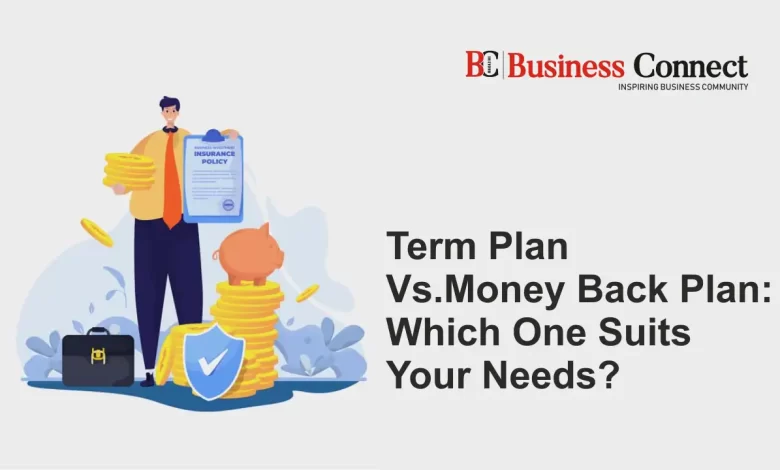Term Plan Vs Money Back Plan: Which One Suits Your Needs?

Deciding the right type of life insurance is considered a vital decision that can significantly impact the financial security of the family members. Regarding investments, there are two main options available, i.e., Term Plan Insurance & Money Back Plan. They both have their own attritions, benefits, applicability, etc., helping to meet the objectives of a policyholder.
Term Plan Vs. Money Back Plan: Which One Suits Your Needs?
A Term Plan is a pure protection plan with no investment component, which means the policyholder receives no sum if he survives the policy tenure. In contrast, a Money-back plan includes both insurance coverage & investment components. Let us discuss the benefits of both types of plans one by one.
Benefits & Features of a Term Plan
Provided are the main benefits of Term Plan Insurance:
- It provides financial assistance to the policyholder’s family members in his/ her absence to maintain their lifestyle & meet their financial obligations.
- These plans are simple enough to underst&, making it easy to underst& the terms & conditions of the policy.
- These plans are flexible, i.e. a policyholder can add riders like accidental death benefits or critical illness.
- A term plan offers a huge amount of coverage at a low premium cost as compared to other insurance policies.
Benefits & features of a Money Back Plan
Provided below are the benefits of a Money Back Plan:
- It offers maturity benefits, i.e., if the policyholder survives the policy tenure, he will receive the sum assured & applicable profits.
- Get tax benefits u/s 80C of the Income Tax Act, but these plans provide an additional tax advantage on the sum of returns received & the maturity amount.
- It offers survival benefits at specific time intervals throughout the policy tenure. It can be used to meet the financial objectives, hence creating financial security.
- A moneyback policy incorporates a factor of investment that allows the policyholder to build the corpus over a specified period. With the help of this corpus, one can meet future expenses related to life events.
Difference between a Term Insurance Plan & a Money Back Plan
| Basis | Money Back Plan | Term Plan |
| Main Objective | It offers dual benefits, i.e., life coverage & survival benefits, which are received during the policy tenure. It involves periodic payments to be received at a specified period during the policy tenure, even if the policyholder survives. | The main objective of a term plan is to provide life coverage for a specified tenure. It gives a sense of financial security & protection to the nominees of the policyholder in case of their sudden demise. |
| Coverage/ Maturity Benefits | This contains life coverage as well as survival benefits. Under this plan, the sum assured will be received even if the policyholder survives the policy tenure. Also, he will be entitled to receive periodic benefits throughout the policy tenure. | There is no survival benefit, i.e. no amount is received if the policyholder survives the policy tenure. A term plan insurance includes only a death benefit, which means an amount given to the nominees of the policyholder in case of their demise. |
| Premium Amount | The premium amount is higher, including life coverage & investment components. | The premium amount is quite low as it only includes life coverage, & no investment coverage is provided. |
| Investment Component | It includes an investment factor, where the amount accumulated throughout the policy tenure will be received in the form of survival benefits afterwards. | Since they do not include any investment component, They only offer death benefits in case of the death of the policyholder, i.e. no savings or survival benefits are included. |
| Tax Benefit | It also offers tax benefits on the premium paid. In addition to this, you also get a tax benefit on the maturity amount & amount of returns received. | It offers tax benefits towards the premium paid under section 80C of the Income Tax Act. |
To have a better understanding of both plans, let us analyze the provided situations:
Situation 1: Long-Term Financial Protection
If you are looking for long-term financial coverage, go for a term plan, as it is one of the cost-effective ways you can secure your future.
Situation 2: Young Professionals with a Limited Budget
For young professionals with a limited budget, a term plan is considered to be more advantageous. This is because it provides high coverage with low premiums, which ensures financial security for their family members.
Situation 3: Individuals with Regular Financial Objectives
Individuals with average financial goals can opt for a money-back plan, as the periodic payments will help them meet their goals along with life coverage.
Situation 4: High-Income Earners with Tax Savings Objectives
As money-back plans provide an added tax advantage, & high-income earners look for tax-saving plans, they both align well with each other. It offers tax advantages on returns & maturity benefits but is not as relevant as other plans.
Conclusion
There are multiple factors on the basis of which one can decide whether to buy a term plan or money-back policy, such as financial objectives, risk appetite, & protection required. Hence, assess your requirements & objectives from the plan & then choose accordingly. If your main objective is only protection coverage at a reasonable cost, go for a term plan.
But if you want some investment factor also to be included, reach out for a money-back plan. A term plan includes payment of a lump sum amount on the demise of the policyholder. On the contrary, in terms of money back, the policyholder gets returns at a regular time period throughout the policy tenure.






